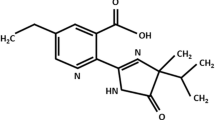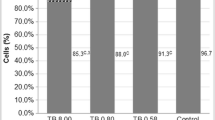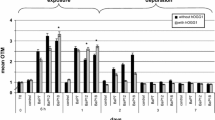Abstract
We studied the toxic effects of glyphosate in vitro on HepG2 cells exposed for 4 and 24 h to low glyphosate concentrations likely to be encountered in occupational and residential exposures [the acceptable daily intake (ADI; 0.5 μg/mL), residential exposure level (REL; 2.91 μg/mL) and occupational exposure level (OEL; 3.5 μg/mL)]. The assessments were performed using biomarkers of oxidative stress, CCK-8 colorimetric assay for cell proliferation, alkaline comet assay and cytokinesis-block micronucleus (CBMN) cytome assay. The results obtained indicated effects on cell proliferation, both at 4 and 24 h. The levels of primary DNA damage after 4-h exposure were lower in treated vs. control samples, but were not significantly changed after 24 h. Using the CBMN assay, we found a significantly higher number of MN and nuclear buds at ADI and REL after 4 h and a lower number of MN after 24 h. The obtained results revealed significant oxidative damage. Four-hour exposure resulted in significant decrease at ADI [lipid peroxidation and glutathione peroxidase (GSH-Px)] and OEL [lipid peroxidation and level of total antioxidant capacity (TAC)], and 24-h exposure in significant decrease at OEL (TAC and GSH-Px). No significant effects were observed for the level of reactive oxygen species (ROS) and glutathione (GSH) for both treatment, and for 24 h for lipid peroxidation. Taken together, the elevated levels of cytogenetic damage found by the CBMN assay and the mechanisms of primary DNA damage should be further clarified, considering that the comet assay results indicate possible cross-linking or DNA adduct formation.






Similar content being viewed by others
References
Alvarez-Moya C, Silva MR, Ramírez CV, Gallardo DG, Sánchez RL, Aguirre AC, Velasco AF (2014) Comparison of the in vivo and in vitro genotoxicity of glyphosate isopropylamine salt in three different organisms. Genet Mol Biol 37(1):105–110
Antoniou M, Habib ME, Howard CV, Jennings RC, Leifert C, Nodari RO, Robinson CJ, Fagan J (2012) Teratogenic effects of glyphosate-based herbicides: divergence of regulatory decisions from scientific evidence. J Environ Anal Toxicol S4 006:1–13
Belsten JL, Wright AJ (1995) European community—FLAIR common assay for whole-blood glutathione peroxidase (GSH-Px); results of an inter-laboratory trial. Eur J Clin Nutr 49(12):921–927
Benachour N, Seralini G (2009) Glyphosate formulations induce apoptosis and necrosis in human umbilical, embryonic, and placental cells. Chem Res Toxicol 22(1):97–105
Benachour N, Sipahutar H, Moslemi S, Gasnier C, Travert C, Seralini GE (2007) Time- and dose-dependent effects of roundup on human embryonic and placental cells. Arch Environ Contam Toxicol 53(1):126–133
Benítez-Leite S, Macchi ML, Acosta M (2009) Malformaciones congenítas asociadas a agrotóxicos. Arch Pediatr Urug 80:237–247
Benzie IF, Strain JJ (1996) The ferric reducing ability of plasma (FRAP) as a measure of “antioxidant power”: the FRAP assay. Anal Biochem 239:70–76
Beuret CJ, Zirulnik H, Gimenez MS (2005) Effect of the herbicide glyphosate on liver lipoperoxidation in pregnant rats and their foetuses. Reprod Toxicol 19:501–504
Bolognesi C, Bonatti S, Degan P, Gallerani E, Peluso M, Rabboni R, Roggieri P, Abbondandolo A (1997) Genotoxic activity of glyphosate and its technical formulation roundup. J Agric Food Chem 45(5):1957–1962
Bolognesi C, Carrasquilla G, Volpi S, Solomon KR, Marshall EJ (2009) Biomonitoring of genotoxic risk in agricultural workers from five Colombian regions: association to occupational exposure to glyphosate. J Toxicol Environ Health A 72(15–16):986–997
Bradford M (1976) A rapid and sensitive method for the quantitation of microgram quantities of protein utilizing the principle of protein-dye binding. Anal Biochem 72:248–254
Carrasco A (2013) Teratogenesis by glyphosate based herbicides and other pesticides: relationship with the retinoic acid pathway. In: Breckling B, Verhoeven R (eds) GM-Crop Cultivation – Ecological Effects on a Landscape Scale.Theorie in der Ökologie 17. Peter Lang, Frankfurt, pp 113–117
Cattani D, de Liz Oliveira Cavalli VL, Heinz Rieg CE, Domingues JT, Dal-Cim T, Tasca CI, Mena Barreto Silva FR, Zamoner A (2014) Mechanisms underlying the neurotoxicity induced by glyphosate-based herbicide in immature rat hippocampus: involvement of glutamate excitotoxicity. Toxicology 320:34–45
Collins AR (2004) The comet assay for DNA damage and repair: principles, applications, and limitations. Mol Biotechnol 26(3):249–261 Review
Columbano A, Rajalakshmi S, Sarma DSR (1981) Requirement of cell proliferation for the initiation of liver carcinogenesis as assayed by three different procedures. Cancer Res 41:2079–2083
Columbano A, Ledda-Columbano GM, Coni P, Sarma DSR, Pani P (1987) Initiation of chemical hepatocarcinogenesis: compensatory cell proliferation verus mitogen induced hyperplasia. In: Roberfroid MB, Préat V (eds) Experimental Hepatocarcinogenesis. Proceedings of European meeting on Experimental Hepatocarcinogenesis. Plenum Press, New York, pp 133–144
de María N, Becerril JM, Garca-Plazaola JI, Hernandez AH, de Felipe MR, Fernández-Pascual M (1996) New insights on glyphosate mode of action in nodular metabolism: role of shikimate accumulation. J Agric Food Chem 54:2621–2628
De Roos AJ, Zahm SH, Cantor KP, Weisenburger DD, Holmes FF, Burmeister LF, Blair A (2003) Integrative assessment of multiple pesticides as risk factors for non-Hodgkin’s lymphoma among men. Occup Environ Med 60(9):E11 1-9
De Roos AJ, Blair A, Rusiecki JA, Hoppin JA, Svec M, Dosemeci M, Sandler DP, Alavanja MC (2005) Cancer incidence among glyphosate-exposed pesticide applicators in the Agricultural Health Study. Environ Health Perspect 113(1):49–54
Dill GM, Sammons RD, Feng PCC, Kohn F, Kretzmer K, Mehrsheikh A, Bleeke M, Honegger JL, Farmer D, Wright D, Haupfear EA (2010) Glyphosate: discovery, development, applications, and properties. In: Nandula VK (ed) Glyphosate Resistance in Crops and Weeds: History, Development, and Management. Wiley, Hoboken, pp 1–34
Dornelles MF, Oliveira GT (2016) Toxicity of atrazine, glyphosate and quinclorac in bullfrog tadpoles exposed to concentrations below legal limits. Environ Sci Pollut Res Int 23(2):1610–1620
Duke S, Powless SB (2009) Glyphosate-resistant crops and weeds: now and in the future. AgBioforum 12(3,4):346–357
Eastmond DA, Tucker JD (1989) Identification of aneuploidy–inducing agents using cytokinesis–blocked human lymphocytes and an antikinetochore antibody. Environ Mol Mutagen 13:34–43
Eriksson M, Hardell L, Carlberg M, Akerman M (2008) Pesticide exposure as risk factor for non-Hodgkin lymphoma including histopathological subgroup analysis. Int J Cancer 123(7):1657–1663
Fenech M (2007) Cytokinesis-block micronucleus cytome assay. Nat Protoc 2(5):1084–1104
Fenech M, Chang WP, Kirsch-Volders M, Holland N, Bonassi S, Zeiger E, Human MicronNucleus project (2003) HUMN project: detailed description of the scoring criteria for the cytokinesis-block micronucleus assay using isolated human lymphocyte cultures. Mutat Res 534(1–2):65–75
Gasnier C, Dumont C, Benachour N, Clair E, Chagnon MC, Séralini GE (2009) Glyphosate-based herbicides are toxic and endocrine disruptors in human cell lines. Toxicology 262:184–191
Gasnier C, Benachour N, Clair E, Travert C, Langlois F, Laurant C, Decroix-Laporte C, Séralini GE (2010) Dig1 protects against cell death provoked by glyphosate-based herbicides in human liver cell lines. J Occup Med Toxicol 27(5):29 1-13
George J, Shukla Y (2013) Emptying of intracellular calcium pool and oxidative stress imbalance are associated with the glyphosate-induced proliferation in human skin keratinocytes HaCaT cells. ISRN Dermatol 825180:1–12
Gniadecki R, Gajkowska B (2003) Intracellular calcium pool emptying induces DNA synthesis in HaCaT keratinocytes. Exp Dermatol 12(4):453–459
Griffiths HR, Dunston CR, Bennett SJ, Grant MM, Phillips DC, Kitas GD (2011) Free radicals and redox signalling in T-cells during chronic inflammation and ageing. Biochem Soc Trans 39(5):1273–1278
Gui YX, Fan XN, Wang HM, Wang G, Chen SD (2012) Glyphosate induced cell death through apoptotic and autophagic mechanisms. Neurotoxicol Teratol 34(3):344–349
Guilherme S, Santos MA, Gaivão I, Pacheco M (2014) DNA and chromosomal damage induced fish (Anguila agula L.) by aminomethylphosphonic acid (AMPA)—the major environmental breakdown product of glyphosate. Environ Sci Pollut Res Int 21(14):8730–8739
Guyton AC, Hall JE (1996) Textbook of medical physiology, 4th edn. W. B. Saunders Company, Philadelphia
Hardell L, Eriksson M, Nordstrom M (2002) Exposure to pesticides as risk factor for non-Hodgkin’s lymphoma and hairy cell leukemia: pooled analysis of two Swedish case-control studies. Leuk Lymphoma 43(5):1043–1049
Harvey AN, Costa ND, Savage JR, Thacker J (1997) Chromosomal aberrations induced by defined DNA double-strand breaks: the origin of achromatic lesions. Somatic. Cell Molec. Genet 23:211–219
IFEN (2006) Report on pesticides in waters: Data 2003–2004. In Dossier. Volume 5. Institut Français de l’Environnement, Orléans, France, pp 15–20
Jayasumana C, Gunatilake S, Senanayake P (2014) Glyphosate, hard water and nephrotoxic metals: are they the culprits behind the epidemic of chronic kidney disease of unknown etiology in Sri Lanka? Int J Environ Res Public Health 11:2125–2147
Jayasumana C, Paranagama P, Agampodi S, Wijewardane C, Gunatilake S, Siribaddana S (2015) Drinking well water and occupational exposure to herbicides is associated with chronic kidney disease, in Padavi-Sripura, Sri Lanka. Environ Health 14(6):1–10
Johansson M, Piha H, Kylin H, Merilä J (2006) Toxicity of six pesticides to common frog (Rana temporaria) tadpoles. Environ Toxicol Chem 25:3164–3169
Kamencic H, Lyon A, Paterson PG, Juurlink BH (2000) Monochlorobimane fluorometric method to measure tissue glutathione. Anal Biochem 286(1):35–37
Knasmüller S, Parzefall W, Sanyal R, Ecker S, Schwab C, Uhl M, MershSundermann V, Williamson G, Hietsch G, Langer T, Darroudi F, Natarajan AT (1998) Use of metabolically competent human hepatoma cells for the detection of mutagens and antimutagens. Mutat Res 402:185–202
Koller VJ, Fürhacker M, Nersesyan A, Mišík M, Eisenbauer M, Knasmueller S (2012) Cytotoxic and DNA-damaging properties of glyphosate and Roundup in human-derived buccal epithelial cells. Arch Toxicol 86(5):805–813
Kozics K, Klusová V, Srančíková A, Mučaji P, Slamenová D, Hunáková L, Kusznierewicz B, Horváthová E (2013) Effects of Salvia officinalis and Thymus vulgaris on oxidant-induced DNA damage and antioxidant status in HepG2 cells. Food Chem 141:2198–2206
Kwiatkowska M, Paweł J, Bukowska B (2013) Glyphosate and its formulations—toxicity, occupational and environmental exposure. Med Pr 64(5):717–729
Kwiatkowska M, Nowacka-Krukowska H, Bukowska B (2014) The effect of glyphosate, its metabolites and impurities on erythrocyte acetylcholinesterase activity. Environ Toxicol Pharmacol 37(3):1101–1108
Larsen K, Najle R, Lifschitz A, Virkel G (2012) Effect of sub-lethal exposure of rats to the herbicide glyphosate in drinking water: glutathione transferase enzyme activities, levels of reduced glutathione and lipid peroxidation in liver, kidneys and small intestine. Environ Toxicol Pharmacol 34(3):811–818
Li AP, Folk RM Monsanto Company Environmental Health Laboratory St Louis, Mo (1983) In vivo bone marrow cytogenetics study of glyphosate in Sprague Dawley rats. (unpublished study dated 20 October 1983, Study #ML-83-236, submitted by Monsanto Co. Washington DC to EFSA)
Lioi MB, Scarfi MR, Santoro A, Barbieri R, Zeni O, Di Berardino D, Ursini MV (1998) Genotoxicity and oxidative stress induced by pesticide exposure in bovine lymphocyte cultures in vitro. Mutat Res 403:13–20
Mañas F, Peralta L, Raviolo J, García OH, Weyers A, Ugnia L, Gonzalez CM, Larripa I, Gorla N (2009a) Genotoxicity of glyphosate assessed by the comet assay and cytogenetic test. Environ Toxicol Pharmacol 28:37–41
Mañas F, Peralta L, Raviolo J, García Ovando H, Weyers A, Ugnia L, Gonzalez Cid M, Larripa I, Gorla N (2009b) Genotoxicity of AMPA, the environmental metabolite of glyphosate, assessed by the comet assay and cytogenetic tests. Ecotoxicol Environ Saf 72(3):834–837
Marques A, Guilherme S, Gaivão I, Santos MA, Pacheco M (2014) Progression of DNA damage induced by a glyphosate-based herbicide in fish (Anguilla anguilla) upon exposure and post-exposure periods—insights into the mechanisms of genotoxicity and DNA repair. Comp Biochem Physiol C Toxicol Pharmacol 166:126–133
Mateos R, Goya L, Bravo L (2004) Determination of malondialdehyde by liquid chromatography as the 2,4-dinitrophenylhydrazone derivative: a marker for oxidative stress in cell cultures of human hepatoma HepG2. J Chromatogr B 805:33–39
McDuffie HH, Pahwa P, McLaughlin JR, Spinelli JJ, Fincham S, Dosman JA, Robson D, Skinnider LF, Choi NW (2001) Non-Hodgkin’s lymphoma and specific pesticide exposures in men: cross-Canada study of pesticides and health. Cancer Epidemiol Biomark Prev 10(11):1155–1163
Mesnage R, Defarge N, de Vendômois JS, Séralini GE (2014) Major pesticides are more toxic to human cells than their declared active principles. Biomed Res Int 179691:1–8
Mladinic M, Berend S, Vrdoljak AL, Kopjar N, Radic B, Zeljezic D (2009a) Evaluation of genome damage and its relation to oxidative stress induced by glyphosate in human lymphocytes in vitro. Environ Mol Mutagen 50(9):800–807
Mladinic M, Perkovic P, Zeljezic D (2009b) Characterization of chromatin instabilities induced by glyphosate, terbuthylazine and carbofuran using cytome FISH assay. Toxicol Lett 189(2):130–137
Monroy CM, Cortés AC, Sicard DM, de Restrepo HG (2005) Cytotoxicity and genotoxicity of human cells exposed in vitro to glyphosate. Biomedica 25(3):335–345
Ohkawa H, Ohishi N, Yagi K (1979) Assay for lipid peroxides in animal tissues by thiobarbituric acid reaction. Anal Biochem 95:351–358
Pareek A, Godavarthi A, Issarani R, Nagori BP (2013) Antioxidant and hepatoprotective activity of Fagonia schweinfurthii (Hadidi) Hadidi extract in carbon tetrachloride induced hepatotoxicity in HepG2 cell line and rats. J Ethnopharmacol 150:973–981
Paz-y-Miño C, Sánchez ME, Arévalo M, Muñoz MJ, Witte T, De-la-Carrera GO, Leone PE (2007) Evaluation of DNA damage in an Ecuadorian population exposed to glyphosate. Genet Mol Biol 30(2):456–460
Peluso M, Munnia A, Bolognesi C, Parodi S (1998) 32P-postlabeling detection of DNA adducts in mice treated with the herbicide Roundup. Environ Mol Mutagen 31(1):55–59
Pieniazek D, Bukowska B, Duda W (2004) Comparison of the effect of Roundup Ultra 360 SL pesticide and its active compound glyphosate on human erythrocytes. Pestic Biochem Physiol 79:58–63
Richard S, Moslemi S, Sipahtur H, Benachour N, Seralini GE (2005) Differential effects of glyphosate and roundup on human placental cells and aromatase. Environ Health Perspect 113(6):716–720
Samsel A, Seneff S (2013a) Glyphosate, pathways to modern diseases II: celiac sprue and gluten intolerance. Interdiscip Toxicol 6(4):159–184
Samsel A, Seneff S (2013b) Glyphosate’s suppression of cytochrome P450 enzymes and amino acid biosynthesis by the gut microbiome: pathways to modern diseases. Entropy 15(4):1416–1463
Samsel A, Seneff S (2016) Glyphosate, pathways to modern diseases V: amino acid analogue of glycine in diverse proteins. J Biol Phys Chem 16:9–46
Sazonova OV, Blishchenko EY, Tolmazova AG, Khachin DP, Leontiev KV, Karelin AA, Ivanov VT (2007) Stimulation of fibroblast proliferation by neokyotorphin requires Ca2+ influx and activation of PKA, CaMK II and MAPK/ERK. FEBS J 274(2):474–484
Schinasi L, Leon ME (2014) Non-Hodgkin lymphoma and occupational exposure to agricultural pesticide chemical groups and active ingredients: a systematic review and meta-analysis. Int J Environ Res Public Health 11(4):4449–4527
Slaninova A, Smutna M, Modra H, Svobodova Z (2009) A review: oxidative stress in fish induced by pesticides. Neuroendocrinol Lett 30:2–12
Suzuki Y, Inoue T, Ra C (2010) L-type Ca2+ channels: a new player in the regulation of Ca2+ signaling, cell activation and cell survival in immune cells. Mol Immunol 47(4):640–648
Thongprakaisang S, Thiantanawat A, Rangkadilok N, Suriyo T, Satayavivad J (2013) Glyphosate induces human breast cancer cells growth via estrogen receptors. Food Chem Toxicol 59:129–136
US EPA (1993) U.S. Environmental Protection Agency Reregistration Eligibility Decision (RED) Glyphosate. USEPA, Washington, DC (EPA-738-R-93-014)
US EPA (2002) U. S. Environmental Protection Agency. Memorandum: glyphosate in/on pasture and rangeland grasses, Roundup ready® wheat, and nongrass animal feeds. Health Effects Division (HED) Risk Assessment. 37 pages: Tolerance, Vol. 69. Number 217. USEPA, Washington, DC https://www3.epa.gov/pesticides/chem_search/cleared_reviews/csr_PC-103601_20-Feb-02_a.pdf
US EPA (2004) U. S. Environmental Protection Agency. Glyphosate: pesticide tolerance, vol. 69. Number 217. USEPA, Washington, DC
US EPA (2011) Edition of the drinking water standards and health advisories. Office of Water USEPA, Washington, DC (EPA 820-R-11-002)
Vasiluk L, Pinto LJ, Moore MM (2005) Oral bioavailability of glyphosate: studies using two intestinal cell lines. Environ Toxicol Chem 24(1):153–160
White CD, Sacks DB (2010) Regulation of MAP kinase signaling by calcium. Methods Mol Biol 661:151–165
WHO (2015) IARC monographs volume 112: evaluation of five organophosphate insecticides and herbicides
Wood CE, Hukkanen RR, Sura R, Jacobson-Kram D, Nolte T, Odin M, Cohen S.M (2015) Scientific and Regulatory Policy Committee (SRPC) review*: interpretation and use of cell proliferation data in cancer risk assessment. Public Health Resources. Paper 318. http://digitalcommons.unl.edu/publichealthresources/318
Wright DC, Geiger PC, Han DH, Jones TE, Holloszy JO (2008) Calcium induces increases in peroxisome proliferator-activated receptor γ coactivator-1α and mitochondrial biogenesis by a pathway leading to p38 mitogen activated protein kinase activation. J Biol Chem 282:18793–18799
Xu J, Li G, Wang Z, Si L, He S, Cai J, Huang J, Donovan MD (2016) The role of L-type amino acid transporters in the uptake of glyphosate across mammalian epithelial tissues. Chemosphere 145:487–494
Zhang W, Liu HT (2002) MAPK signal pathways in the regulation of cell proliferation in mammalian cells. Cell Res 12:9–18
Zhang YP, Wang WL, Liu J, Li WB, Bai LL, Yuan YD, Song SX (2013) Plasminogen activator inhibitor-1 promotes the proliferation and inhibits the apoptosis of pulmonary fibroblasts by Ca(2+) signaling. Thromb Res 131(1):64–71
Acknowledgments
This work was financially supported by Project No. 8366 Organic Pollutants in Environment—Markers and Biomarkers of Toxicity (OPENTOX), funded by the Croatian Science Foundation.
Author information
Authors and Affiliations
Corresponding author
Ethics declarations
Conflict of interest
The authors declare that they have no conflict of interest.
Additional information
Responsible editor: Philippe Garrigues
Electronic supplementary material
Supplementary Table 1
(DOCX 15 kb).
Rights and permissions
About this article
Cite this article
Kašuba, V., Milić, M., Rozgaj, R. et al. Effects of low doses of glyphosate on DNA damage, cell proliferation and oxidative stress in the HepG2 cell line. Environ Sci Pollut Res 24, 19267–19281 (2017). https://doi.org/10.1007/s11356-017-9438-y
Received:
Accepted:
Published:
Issue Date:
DOI: https://doi.org/10.1007/s11356-017-9438-y




